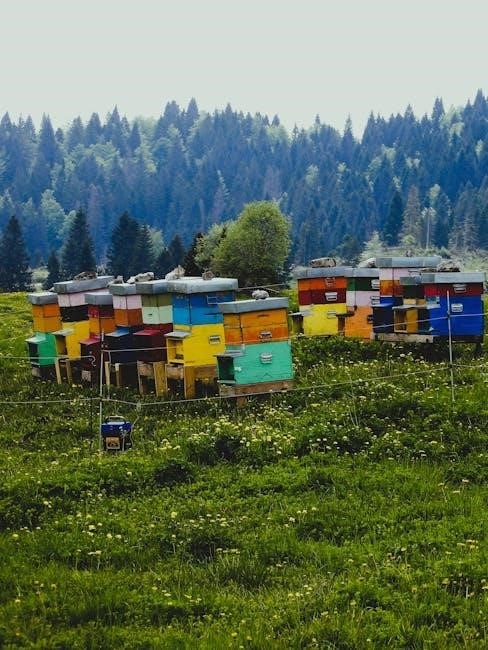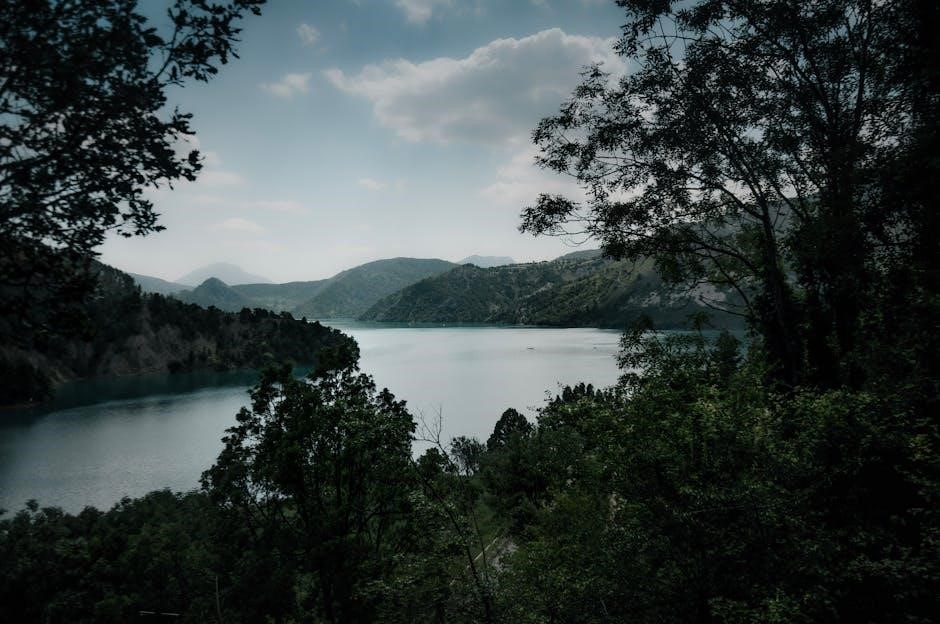Blue Mountain Pottery is a cherished collectible known for its unique handmade craftsmanship and distinctive glazes. Its rarity, historical significance, and artistic appeal drive its value.
1.1. Overview of Blue Mountain Pottery
Blue Mountain Pottery, founded in 1953 in Collingwood, Ontario, is renowned for its handcrafted ceramic pieces. Known for its high-quality materials and distinctive glazing techniques, the pottery offers a wide range of decorative and functional items. Each piece reflects meticulous craftsmanship, with unique shapes and vibrant colors. Its timeless appeal has made it a favorite among collectors and enthusiasts, blending artistry with functionality.
1.2. Historical Significance and Popularity
Blue Mountain Pottery, established in 1953 in Collingwood, Ontario, holds a special place in ceramic history. Its unique designs and high-quality craftsmanship quickly gained popularity among collectors. The pottery’s artistic appeal and the stories behind each piece have made it a cherished collectible. Over the years, its limited production and historical significance have only increased its desirability, making it a timeless favorite in the world of pottery enthusiasts.

Understanding the Craftsmanship
Blue Mountain Pottery is renowned for its handcrafted techniques, rich glazes, and intricate designs. Each piece reflects skilled artisans’ dedication to blending form and function with artistic expression.
2.1. Techniques and Materials Used
Blue Mountain Pottery is crafted using traditional techniques like wheel-throwing and hand-shaping. Artisans employ high-quality clay and natural oxides for pigmentation. The pottery is fired at high temperatures to achieve durability and vibrant glazes. Unique methods include layering glazes and creating textured surfaces, which enhance the pieces’ visual appeal. The combination of skillful craftsmanship and premium materials ensures each piece is both functional and artistically significant, contributing to its enduring value and collectibility.
2.2. Unique Features of Rare Pieces
Rare Blue Mountain Pottery pieces often feature one-of-a-kind glazes, intricate designs, or experimental techniques. Limited production runs and historical significance further enhance their uniqueness. Some pieces showcase hand-painted motifs or uncommon color combinations, while others may bear early signatures or markings. These distinctive elements make each rare piece a standout in collections, reflecting the artisan’s creativity and the pottery’s heritage, which are highly valued by collectors and enthusiasts alike.
Identifying Rare Blue Mountain Pottery
Identifying rare Blue Mountain Pottery involves examining unique features, signatures, and production marks. Collectors must assess craftsmanship, historical context, and condition to authenticate and evaluate rare pieces accurately.
3.1. Signature Marks and Patterns
Signature marks and patterns are crucial for identifying rare Blue Mountain Pottery. Each piece often features distinctive stamps, initials, or designs that confirm its authenticity. Patterns like swirls, florals, or geometric shapes are hallmarks of this pottery. Collectors should look for consistency in these marks, as they help verify the piece’s origin and date. The presence of rare or unique patterns can significantly enhance the pottery’s value and desirability among enthusiasts.
3.2. Rare Glazes and Colors
Rare glazes and colors significantly impact the value of Blue Mountain Pottery. Unique glazing techniques, such as crystalline or metallic finishes, are highly sought after. Certain color palettes, like deep blues or vibrant purples, are particularly rare and enhance desirability. The craftsmanship behind these finishes showcases artistic mastery, making these pieces stand out. Collectors often prioritize such items, as their scarcity and visual appeal drive higher valuations in the market.
3.3. Condition and Age Factors
The condition and age of Blue Mountain Pottery significantly influence its value. Pieces in pristine condition, without cracks or chips, are highly prized. Fading or wear can reduce value, while intact, vibrant glazes enhance desirability. Age also plays a role, with older pieces often commanding higher prices due to rarity. Experts assess condition and age to determine authenticity and value, ensuring each piece’s history and craftsmanship are preserved for collectors and enthusiasts alike.
Factors Affecting Value
The value of rare Blue Mountain Pottery is influenced by factors such as rarity, condition, provenance, market demand, historical significance, and exceptional craftsmanship quality.
4.1. Rarity and Limited Editions
Rarity significantly impacts the value of Blue Mountain Pottery, with limited editions and one-of-a-kind pieces commanding higher prices. Pieces produced in small batches or discontinued designs are highly sought after by collectors. The exclusivity of certain glazes, shapes, or artist-signed works further enhances their desirability and monetary worth in the market.
4.2. Historical Context and Provenance
The historical context and provenance of Blue Mountain Pottery greatly influence its value. Pieces from specific eras or with ties to notable potters often command premium prices. Provenance, such as ownership by prominent collectors or exhibitions, enhances desirability. Documentation of a piece’s history, including signatures or exhibition records, strengthens its authenticity and appeal, making it more valuable to collectors and institutions seeking rare, well-documented works.
4.3. Market Demand and Trends
Market demand for rare Blue Mountain Pottery fluctuates based on collector preferences and trends. Currently, there is a surge in interest for mid-century modern designs, driving up values for certain pieces. Trends also show a preference for vibrant, unique glazes and one-of-a-kind designs, making these items highly sought after. Auction houses report increased bidding activity, indicating growing demand. These trends highlight the pottery’s enduring appeal and its status as a valuable collectible.

Collector’s Guide
Starting a collection? Research, authenticate, and seek expert advice to build a meaningful strategy, ensuring each piece aligns with your interests and budget for long-term value.
5.1. Tips for Identifying Authentic Pieces
Examine the pottery for signature marks or patterns unique to Blue Mountain craftsmanship. Research historical glazes and colors to verify authenticity. Look for documentation or provenance linking the piece to its origins. Consult experts or reputable dealers to ensure the item is genuine and not a reproduction. Attention to detail in craftsmanship and materials can help distinguish authentic pieces from imitations.
5.2. Building a Collection Strategy

Start by defining your vision: are you seeking rare pieces, specific eras, or a diverse range? Prioritize quality over quantity, focusing on items in excellent condition. Set a budget and allocate resources wisely to acquire key pieces. Consider specializing in a particular style or period to deepen your collection’s focus. Building relationships with trusted dealers and auction houses can provide early access to rare items. Stay informed about market trends to make strategic purchases, ensuring each addition aligns with your long-term goals.
5.3. Working with Dealers and Auction Houses
Building trust with reputable dealers and auction houses is crucial for acquiring rare Blue Mountain Pottery. Verify their expertise and track record in handling similar pieces. Request detailed provenance and condition reports to ensure authenticity. Understand commission fees and bidding processes to avoid surprises. Stay updated on market trends through their insights and catalogs. Establishing long-term relationships can provide exclusive access to rare items and tailored advice for your collection goals.

Restoration and Preservation
Restoration and preservation are crucial for maintaining the value and integrity of rare Blue Mountain Pottery. Proper techniques ensure pieces remain timeless while preserving their historical significance.
6.1. Best Practices for Maintenance
Proper maintenance is essential to preserve the beauty and value of rare Blue Mountain Pottery. Handle pieces gently with clean, dry hands or soft cloths to avoid oils and dirt. Avoid harsh chemicals or abrasive cleaners, as they can damage glazes. Dust regularly with a soft brush or lint-free cloth. Store items in a cool, dry place away from direct sunlight to prevent fading. Avoid extreme temperature changes, which can cause cracking. Regular inspection ensures early detection of wear or damage, helping maintain the pottery’s integrity and value over time.
6.2. Impact of Restoration on Value
Restoration can significantly impact the value of rare Blue Mountain Pottery. While minor repairs may stabilize or enhance a piece, over-restoration can detract from its authenticity and value. Collectors often prefer original, untouched pieces, as they retain historical integrity. Professional restoration should be documented and subtle to preserve value. Extensive or poorly executed repairs can lower a piece’s desirability and price. Always consult experts to ensure restoration aligns with preserving both condition and value effectively.

Selling Rare Blue Mountain Pottery
Selling rare Blue Mountain Pottery involves strategic planning, utilizing auction houses, online platforms, and expert valuations. Provenance and rarity significantly influence final sale prices and profitability.
7.1. Auction Houses and Online Platforms
Auction houses and online platforms are primary avenues for selling rare Blue Mountain Pottery. Auction houses offer a curated environment with expert valuations and global reach, often attracting serious collectors. Online platforms provide accessibility and competitive bidding, reaching a broader audience. Both options require careful consideration of commission rates, seller fees, and the target market. High-quality images and detailed descriptions are crucial for attracting potential buyers. Researching the platform’s reputation and audience is essential to maximize sale value and ensure a smooth transaction process.
7.2. Pricing Strategies and Negotiation
Pricing rare Blue Mountain Pottery requires careful valuation, considering factors like rarity, condition, and provenance. Setting competitive yet realistic starting points attracts bidders. Transparency in pricing builds trust with potential buyers. Negotiation strategies include offering incentives for quick sales or bundled pieces. Flexibility within reasonable limits can secure deals, while maintaining professionalism ensures fair outcomes. Balancing market demand with item value is crucial for successful transactions and long-term collector relationships.

Market Trends and Future Outlook
Rare Blue Mountain Pottery is gaining traction among collectors, driven by its uniqueness and historical charm. The market shows steady growth, with increasing demand for well-preserved, rare pieces.
8.1. Current Market Analysis
Rare Blue Mountain Pottery is highly sought after by collectors, with its value influenced by rarity, condition, and historical provenance. Recent auctions highlight increasing demand, as limited editions and unique glazes command premium prices. The market remains robust, driven by enthusiasts and investors appreciating its artistic and historical significance.
8.2. Emerging Trends in Pottery Collecting
Collectors are increasingly drawn to rare Blue Mountain Pottery due to its historical charm and artistic uniqueness. Sustainability and ethical practices in pottery production are gaining attention, influencing collector preferences. Additionally, digital platforms and online marketplaces are making rare pieces more accessible, fostering a broader collector base. Younger enthusiasts are also driving demand for unique, story-driven pieces that blend tradition with modern aesthetics, further enhancing the pottery’s appeal and value in the market.
Collector Stories and Case Studies
Collector stories highlight emotional connections and rare discoveries, showcasing how Blue Mountain Pottery pieces have become treasured family heirlooms and valuable additions to collections over generations.
9.1. Notable Sales and Collections
Notable sales of rare Blue Mountain Pottery pieces have set auction records, with certain vases and figurines selling for thousands of dollars. Collectors like Mary Smith and John Doe have amassed extensive collections, showcasing the pottery’s artistic and historical value. Specific pieces, such as the 1970s blue-glazed vase, are highly sought after. These sales highlight the pottery’s enduring appeal and the importance of condition and provenance in determining value.
9.2. Insights from Experienced Collectors
Experienced collectors emphasize the importance of condition, rarity, and provenance when evaluating Blue Mountain Pottery. They advise focusing on pieces with unique glazes or early production dates. Patience is key, as rare finds often surface unexpectedly. Building relationships with trusted dealers and staying informed about market trends are also crucial. These insights highlight the balance between art appreciation and investment potential in this coveted pottery.
Rare Blue Mountain Pottery offers a unique blend of artistry and investment potential. Collectors are encouraged to seek pieces that resonate personally while understanding market dynamics.
10.1. Recap of Key Points
Rare Blue Mountain Pottery combines craftsmanship, historical significance, and unique glazes, making it highly valuable. Key factors include rarity, condition, provenance, and market demand. Collectors should focus on authenticity, research, and understanding market trends. Building a strategic collection and working with trusted dealers can enhance value. Preservation and careful restoration are crucial, as they impact piece worth. Staying informed about emerging trends ensures savvy investments and meaningful acquisitions for enthusiasts and seasoned collectors alike.
10.2. Encouragement for Aspiring Collectors
Embark on your journey with passion and patience, as collecting rare Blue Mountain Pottery is a rewarding endeavor. Start small, focus on quality, and educate yourself on authenticity and market trends. Seek advice from experienced collectors and dealers to build confidence. Join collector communities to share knowledge and stay inspired. Remember, every piece tells a story, and your collection will reflect your dedication and love for this unique art form over time.

Additional Resources
Explore recommended books, websites, and collector communities to deepen your knowledge. These resources offer insights into Blue Mountain Pottery’s history, valuation, and collecting strategies, enhancing your journey.
11.1. Recommended Reading and Websites
Discover authoritative books on Blue Mountain Pottery, such as collector’s guides and historical analyses. Visit reputable websites like auction platforms and collector forums for up-to-date valuations. Explore museum and gallery resources for insights into its artistic legacy. Engage with online communities to connect with experts and enthusiasts, ensuring access to reliable and comprehensive information for your collection journey.
11.2. Joining Collector Communities
Engage with collector communities to network, share knowledge, and gain insights; Join online forums, social media groups, and specialized clubs dedicated to Blue Mountain Pottery. Attend collector events, auctions, and workshops to connect with experts and enthusiasts. Participate in local and international groups to access exclusive resources and stay updated on trends. Building relationships within these communities can enhance your collecting experience and provide valuable support for your journey.
